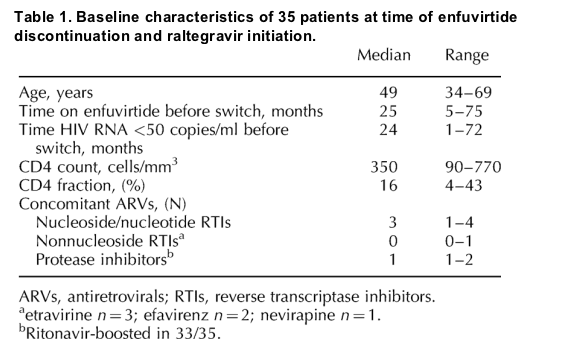| |
Outcomes of multidrug-resistant patients switched from enfuvirtide to raltegravir within a virologically suppressive regimen
[Research Letters]
|
| |
| |
AIDS:Volume 22(10)19 June 2008p 1224-1226
Harris, Mariannea; Larsen, Gerenea; Montaner, Julio SGa,b
aAIDS Research Programme, St Paul's Hospital, Providence Healthcare, Canada
bBritish Columbia Centre for Excellence in HIV/AIDS and the University of British Columbia, Vancouver, British Columbia, Canada.
ABSTRACT: Enfuvirtide has been a cornerstone of salvage therapy for multidrug-resistant HIV. Raltegravir provides another novel class option, with the advantages of easier administration and improved tolerability. Thirty-five adults electively replaced enfuvirtide with raltegravir while the rest of their regimen was unchanged. All maintained virologic suppression after a median of 7 months except one who experienced a transiently detectable viral load after 5 months. The new regimen was well tolerated with no apparent new drug-related adverse clinical or laboratory events.
The fusion inhibitor enfuvirtide and the integrase inhibitor raltegravir each have demonstrated antiviral activity in treatment-experienced patients with HIV resistant to nucleosides (NRTI), nonnucleosides (NNRTI), and protease inhibitors [1-4]. While enfuvirtide has been a cornerstone of salvage therapy in this setting, its long-term tolerability has often been hampered by the need of twice-daily subcutaneous injections and persistent injection site reactions [5]. Recently, raltegravir has become an alternative to enfuvirtide in this setting. Raltegravir is a well tolerated oral agent in a new class without crossresistance to the NRTI, NNRTI, and protease inhibitor classes [6].
We offered an elective switch from enfuvirtide to raltegravir to all HIV-positive adults who had plasma HIV RNA less than 50 copies/ml (Roche HIV-1 RNA Ultrasensitive PCR assay) and who had ongoing injection site reactions and/or injection fatigue while receiving an enfuvirtide-containing regimen within a single tertiary care HIV clinic (John Ruedy Immunodeficiency Clinic, St Paul's Hospital, Vancouver, British Columbia). The switch was accomplished in a single day without overlapping dosing. The remainder of the salvage regimen was left unchanged. Raltegravir was obtained through the Special Access Programme of Health Canada, and was administered in doses of 400 mg orally twice daily. Patients received clinical and laboratory follow-up according to standard clinical practice after the change in regimen.
Thirty-five patients (34 male) switched from enfuvirtide to raltegravir between 20 November 2006 and 19 October 2007. At the time of the switch, patients had received enfuvirtide for a median of 25 months (range 5-75 months) and had sustained HIV RNA less than 50 copies/ml for a median of 24 months (range 1-72 months) (Table 1). Concomitant antiretrovirals included one to four nucleoside or nucleotide RTI in all patients, one NNRTI in six patients, and one or two protease inhibitors in all patients. Twenty-six patients received a single protease inhibitor: lopinavir/ritonavir (n = 9), darunavir/ritonavir (n = 8), or atazanavir (n = 7 ritonavir-boosted, n = 1 unboosted). Of note, one patient was receiving tipranavir/ritonavir, which is known to reduce raltegravir trough levels by 55% [7]. Eight patients received dual boosted protease inhibitors: lopinavir/saquinavir (n = 5), lopinavir/atazanavir (n = 2), or atazanavir/saquinavir (n = 1). One patient received atazanavir/saquinavir without ritonavir boosting.

As of 10 January 2008, all 35 patients remain on raltegravir after a median follow-up time of 7 months (range 1-13 months), and none have resumed enfuvirtide. Thirty-four patients have HIV RNA less than 50 copies/ml. The remaining patient had HIV RNA less than 50 copies/ml at 1 and 2 months and 60 copies/ml after 5 months on raltegravir. His concurrent regimen consists of ritonavir-boosted atazanavir and lamivudine, and he had previously experienced intermittent viral load blips less than 100 copies/ml while taking enfuvirtide. The only patient who received concomitant tipranavir/ritonavir (in addition to tenofovir, zidovudine, lamivudine, and abacavir) has sustained a plasma HIV RNA less than 50 copies/ml for 6 months after the switch to raltegravir. Plasma raltegravir levels have not been measured.
Injection site reactions resolved in all patients after enfuvirtide was discontinued. Five patients have experienced new clinical events, but no new laboratory events were observed. Early events occurring within 1 month after the switch to raltegravir were mild peripheral neuropathy and diarrhea; exacerbation of depression; and prostate cancer (in a 56-year-old man). One patient experienced two episodes of pneumonia after 1 and 6 months on raltegravir. In addition, a B-cell lymphoma was diagnosed in a 52-year-old man after 9 months on raltegravir. It is unlikely that any of these events can be directly attributed to raltegravir. Whereas excessive rates of depression with raltegravir as compared with placebo have not been reported in phase II and III clinical trials [3,4,6], anecdotal reports are emerging of psychiatric disorders, including depression, temporally related to the onset of raltegravir therapy [J Gatell, P Ruane, personal communication]. These observations require further study as the clinical use of raltegravir expands into broader patient populations.
On the basis of these results, changing from enfuvirtide to raltegravir within a virologically suppressive regimen appears to be well tolerated and effective, at least over the short term, in patients with multidrug-resistant HIV. The switch from an injectable to an oral medication is highly acceptable to patients and may facilitate long-term adherence. In addition, this strategy is economically attractive based on the higher price of enfuvirtide.
|
|
| |
| |
|
|
|